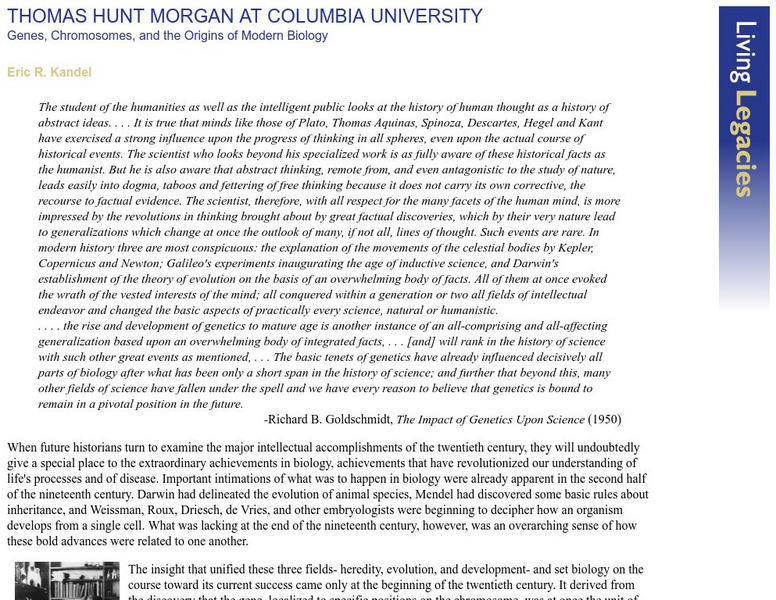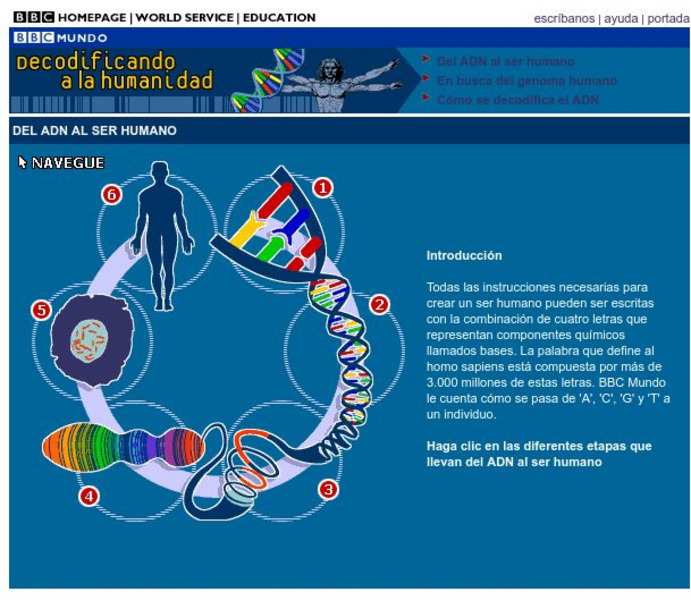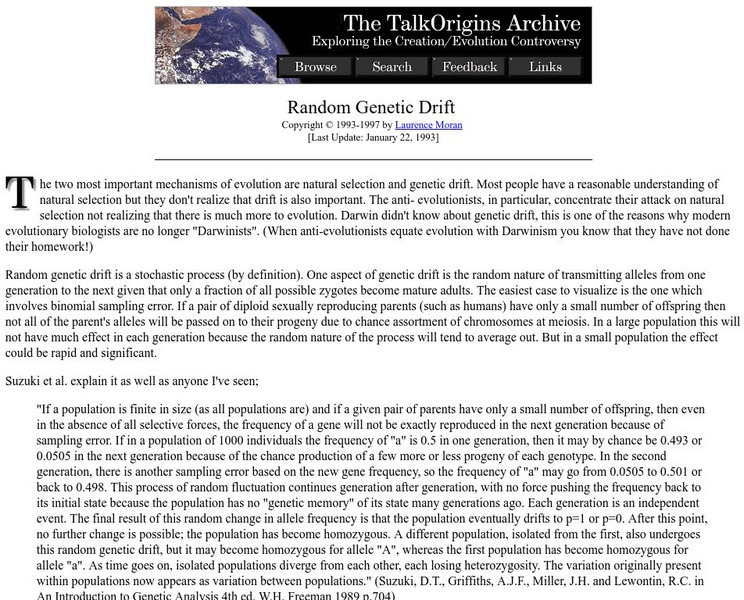PBS
Pbs Learning Media: How Cancer Cells Grow and Divide
This animation from NOVA: "Battle in the War on Cancer: Breast Cancer" describes how oncogenes cause cancer and how cancerous cells can spread throughout the body.
Columbia University
Columbia University: Thomas Hunt Morgan
The site promotes the importance of Morgan and his experiments in genetics with fruit flies on the field of biology.
Utah State Office of Education
Utah Science: Pass It On!
"Pass It On!" will enhance learning about genetics. Delve into activities addressing traits, DNA, sexual and asexual reproduction.
BBC
Bbc Mundo: Decodificando a La Humanidad Del Adn
Learn about DNA and decoding the human genome by clicking graphical DNA models. You can also review a timeline that shows important moments in human genetics research. In Spanish.
PBS
Pbs Learning Media: Should We Grow Gm Crops?
Learn the pros and cons of genetically modified (GM) crops, and cast your vote on whether they should be grown. From the FRONTLINE/NOVA: Harvest of Fear Web site.
Palomar Community College District
Palomar College: Practice Quiz for Mendelian Genetics
This site from Palomar College provides an online practice quiz includes history as well as some of the genetics. Includes feedback. A great learning and practice site.
Other
Personal/history of Genetics Timeline
Wonderful list important events in genetics history between 1651-1999. One-sentence description of each event is provided.
The Franklin Institute
The Franklin Institute: Heart Health and Care
This is a simple guide from The Franklin Institute to keeping your heart healthy through proper exercise, a varied diet, and a clean lifestyle. Here, read about how to exercise and eat to avoid heart disease.
Other
Conservation Ecology: Assessing Extinction Risk
This site discusses how genetic variability is correlated with the risk of organism extinction. It also discusses how bottlenecks can reduce genetic variability in populations leading to extinctions.
Khan Academy
Khan Academy: Polygenic Inheritance and Environmental Effects
Learn about traits that are controlled by multiple genes and/or influenced by the environment. Understand penetrance and expressivity.
National Cancer Institute at the National Institutes of Health
National Cancer Institute: Cancer Genetics Overview
This site provides extensive information about the relationship of genetics to cancer.
Curated OER
Kids Health: The Basics on Genes and Genetic Disorders
Genes can sometimes be a difficult topic for students to understand, but this article provides a nice description of genes, how they work, and the disorders that can sometimes arise. The article also touches on how genetic engineering...
CK-12 Foundation
Ck 12: Gene Regulation and Cancer Advanced
[Free Registration/Login may be required to access all resource tools.] This article complete with labeled diagrams, key vocabulary terms, and review questions explains the connection between gene regulation and cancer.
Curated OER
Kids Health: When You Are a Twin or Triplet
"Have you ever wondered what it feels like to be a twin?" KidsHealth considers the types, troubles, and terrific things about twins and triplets.
Nobel Media AB
The Nobel Prize: The Nobel Prize in Physiology or Medicine 1933
At this site from The Nobel Foundation you can read about Thomas Hunt Morgan, the scientist who won the Nobel Prize in Medicine "for his discoveries concerning the role played by the chromosome in heredity." This website is organized...
CK-12 Foundation
Ck 12: The Hereditary Material
[Free Registration/Login may be required to access all resource tools.] Informational text about the hereditary material in bacteriophages. After reading the text, review the key vocabulary terms and answer some review questions.
Sophia Learning
Sophia: Basic Concepts of Heredity
An introductory lesson on the basics of heredity, and the inheritance of genetic traits. [7:57]
Talk Origins Archive
Talk Origins Archive: Random Genetic Drift
Laurence Moran discusses one of the most important mechanisms of evolution, Random Genetic Drift.
Other
Lawrence Livermore National Lab: Probabilities of Traits
This site explains how to determine the chances of inheriting certain traits from our parents. It gives mathematical examples and exercises.
Other
Simply Psychology: Saul Mc Leod: Nature vs. Nurture in Psychology
There are five approaches to psychology which are on a spectrum from nature versus nurture. The approaches with inherited traits lean towards the nature end and those with acquired traits are on the nurture end. This article helps...
Other
March of Dimes Medical Reference: Tay Sachs Disease
The March of Dimes Foundation offers a general overview of Tay-Sachs disease and how it is transmitted, carried, and treated.
CK-12 Foundation
Ck 12: Life Science: 10.25 Primates and Humans
Understand the genetic similarities between humans and primates.
CK-12 Foundation
Ck 12: Life Science: 4.8 Hardy Weinberg
Understand the conditions required for the Hardy-Weinberg model in evolution.
University of Kansas Medical Center
Univ. Of Kansas Medical Center: Accredited Programs
This site from the University of Kansas Medical Center provides a list and direct links to colleges with accredited genetic counseling programs.




















